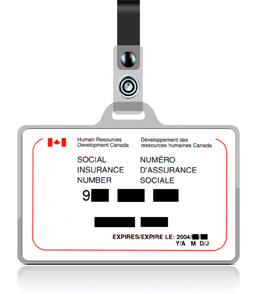Lesson 2
1. Lesson 2
Module 8: Permutations, Combinations, and the Binomial Theorem
Lesson 2: Permutations
Focus

tag: iStockphoto/Thinkstock; SIN card: ![]() Creative Commons
Creative Commons
Attribution-Share Alike 3.0 Unported
One of your most important pieces of identification is your Social Insurance Number (SIN). This nine-digit number is used by the government to identify you.
The first digit in your SIN indicates the area of Canada where the card was issued. If the first digit is a 1, the number was issued in Atlantic Canada. Quebec gets 2 and 3, while 4 and 5 are for Ontario, 6 is for the Prairie provinces (Manitoba, Saskatchewan, and Alberta) and the Northwest Territories and Nunavut, 7 is for British Columbia and the Yukon, 9 is for temporary residents, and 8 and 0 are not used. Assuming there are no other restrictions, how many SINs are available to Alberta residents?
Lesson Outcomes
At the end of this lesson you will be able to
- determine the number of permutations of objects when
- not all objects are being arranged
- some objects are identical
- there are conditions on the permutations
- solve equations involving factorial notation
Lesson Questions
You will investigate the following questions:
- How can you determine the number of permutations when not all objects need to be arranged or some of the objects are identical?
- Are some counting methods more efficient than others in solving certain problems?
- How do you solve equations involving factorial notation?
Assessment
Your assessment may be based on a combination of the following tasks:
- completion of the Lesson 2 Assignment (Download the Lesson 2 Assignment and save it in your course folder now.)
- course folder submissions from Try This and Share activities
- additions to Glossary Terms and Formula Sheet
- work under Project Connection